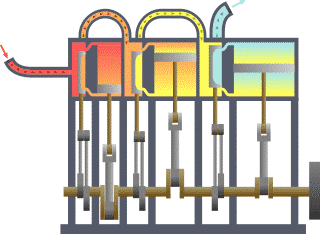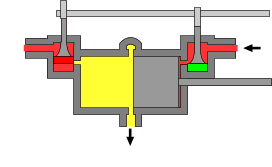
The steam engine was one of the most important invention in the Industrial Revolution. Steam engines were used to pump water out of mines in England. The discovery that steam could be made to work if not for James Watt. We do not know exactly who made that discovery, but we do know that the ancient Greeks had an idea about steam engines. James Watt, however, is given responsibility with inventing the first practical engine. The history of the "modern" steam engine begins with James Watt.
Steam engines are still used today to help run nuclear power plants. The Watt - a unit of power familiar today when dealing with light bulbs - was named after James Watt. James Watt came up with the term 'horsepower' as a way to help explain how much work his steam engines could do for a potential buyer.
 This is an double acting station engine. The valve allows high-pressure steam to act alternately on both faces of the piston. It explains where the "choo-choo" sound comes from
This is an double acting station engine. The valve allows high-pressure steam to act alternately on both faces of the piston. It explains where the "choo-choo" sound comes from
An animation of a simplified triple-expansion engine.
High-pressure steam (red) enters from the boiler and passes through the engine, exhausting as low-pressure steam (blue) to the condenser.
Schematic animation of a uni flow steam engine.
The poppet valves are controlled by the rotating camshaft at the top. High pressure steam enters, red, and exhausts, yellow.

This might be the future of trains.


No comments:
Post a Comment